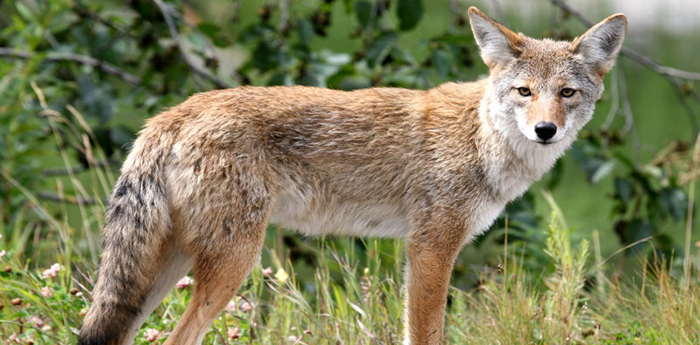
By ANNA ROSSOW
Capital News Service
LANSING – Some residents across Michigan are becoming more familiar with unexpected visitors roaming the streets.
Coyote sightings in residential neighborhoods have become more common due to the canines’ drive for food and quick adaptability skills, experts say.
Coyotes prey on rabbits, chipmunks and squirrels, small animals that enter in and out of urban and suburban areas.
According to Michigan Wildlife Solutions, a pest control company in Fenton, coyotes traditionally stay in wooded, secluded regions, but have become increasingly comfortable with entering residential areas.
They typically weigh around 25 pounds, with lanky legs and a fluffy coat.
“People just don’t realize coyotes are there and now they’re being spotted,” said Brian Roell, a wildlife biologist and the large carnivore specialist at the Department of Natural Resources. “Most of these animals have been there for years and years – you just never saw them.”
“They may be getting a little bit more bold right now,” Roell said.
Roell said coyotes don’t follow territorial lines as much as wolves do and may step out of their home range.
Due to the spring mating season, he said this year’s pups are now old enough to disperse from their litter. Younger ones may be on the hunt for a place to live.
Although coyotes can be found in every county, according to news outlets the most recent sightings of these animals in residential areas include Rogers City, Dearborn and Metro Detroit.
Justin Tomei, the policy and government affairs manager at the Michigan United Conservation Clubs, or MUCC, said another reason for them creeping into residential areas is the loss of habitats due to human expansion.
However, he said coyotes are good predators and prey on many species. He also said that they don’t have many natural predators in the Lower Peninsula.
Their biggest predators in Michigan are gray wolves and cougars, both of which are typically found only in the Upper Peninsula.
According to the DNR, the most recent reported cougar sighting in the Lower Peninsula was in Clinton County in 2017.
Overall, humans pose the biggest threat to coyotes.
“They have learned that they can live in and around humans, and they have dealt with that lifestyle where they can try to avoid humans,” said Roell. “Obviously humans are a danger to them, whether it’s killing or whether it’s hunting.”
Due to their drive for food, coyotes are overcoming their fear of humans, he said,
“People that have well-manicured lawns with ornamental trees, a lot of which are fruit trees, will draw in the squirrels, rabbits, the deer, all those kinds of things,” said Roell. “If you bring in the prey, the predators will follow.”
“Some of them are so smart that I’ve seen that they can figure out which day is garbage day. When you’re setting out those garbage cans, that’s basically a dinner bell for a lot of different wildlife,” he said.
He said all wildlife can be dangerous, but coyotes aren’t usually a threat to humans.
Roell said that in general, wildlife are more scared of humans than humans are of them. He also said some people may not like the idea of a predator near them, and it’s “in the eye of the beholder” as to which is more scared of the other.
Regulations for hunting coyotes in Michigan changed this year.
Tomei said the state Natural Resources Commission shortened the hunting season, which had been year-round, but starting this year runs for nine months from mid-July to mid-April.
MUCC has sued the commission over that decision on the grounds that spring “is the best time to manage coyotes, both at local levels and for depredation on livestock and other game species,” said Tomei.
In 1996, voters gave the commission “exclusive authority” to determine hunting regulations. It is charged with using science and data in decision-making, he said.
“When they closed the season in March, from MUCC’s perspective they violated their legal charge and responsibility of following the best available science,” said Tomei.
Although the DNR doesn’t track the coyote population, Tomei said they can be managed through nuisance calls, sightings and hunter satisfaction.
Roell said people historically have tried to get rid of coyotes in various ways such as bounties, poisoning with cyanide and explosives. None of them worked.
“They’re kind of like the cockroach of the mammal world,” said Roell.